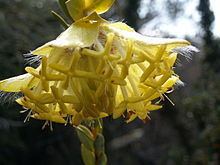Rank Species | ||
 | ||
Similar Pimelea spectabilis, Pimelea physodes, Pimelea calcicola, Pimelea octophylla, Pimelea alpina | ||
Pimelea suaveolens, commonly known as the scented banjine or silky-yellow banjine is a slender shrub with large, rather hairy yellow inflorescences. It ranges in forest areas of south–west Western Australia from New Norcia to Albany.
Contents
Description
Scented banjine grows as an erect, spindly, often multi-stemmed shrub 0.25-1.2 metres (1–4 ft) high. The stems and leaves are glabrous, the leaves opposite, sword–shaped and 1–3 cm long. The inflorescences consist of many flowers surrounded by hairy, petal-like bracts in 4–7 pairs. The inflorescence appear from June to October, are 3–4 cm across, pale to deep yellow and hang from the branches.
Taxonomy
P. suaveolens was first described by Carl Meissner in Plantae Preissianae, Volume 1 pages 603–604 from a specimen collected by James Drummond at Greenmount in 1839. The specific epithet (suaveolens) is derived from a Latin word meaning sweet–smelling or fragrant.
There are two subspecies–
Distribution and habitat
This species grows on sand, sandy clay, gravel and laterite on undulating plains, flats, ridges and roadsides. It occurs in the Coolgardie, Avon Wheatbelt, Esperance Plains, Geraldton Sandplains, Mallee, Swan Coastal Plain, Jarrah Forest and Warren biogeographical regions of Western Australia.
Conservation status
P. suaveolens is classified as a not threatened.
Cultivation
This species is not difficult to propagate from cuttings but is difficult to maintain in cultivation. "Good drainage and partial shade are important."
